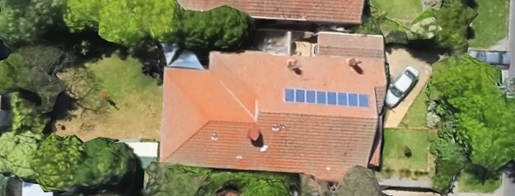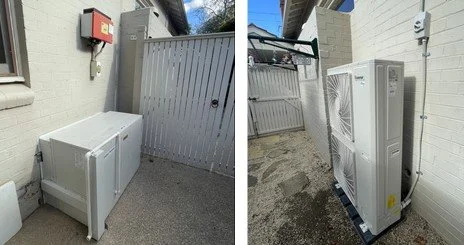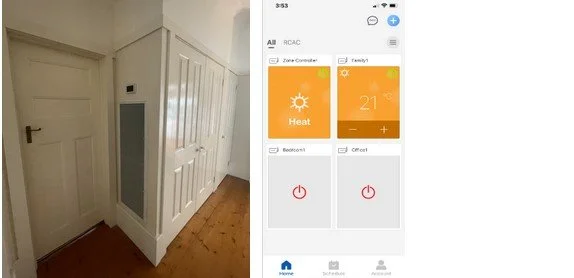A Case Study of upgrading Gas Ducted Heating
An Electrify Boroondara volunteer shares their experience with upgrading their gas ducted heating system.
Introduction
Heating homes in the cooler months is one of the larger household energy costs and contributors to emissions and many households are looking to upgrade their heating from gas to electric. Like many older and larger homes in Boroondara our house has some particular characteristics and this blog describes our experience with electrifying the heating. Our objective was to replicate the previous level of comfort, reduce overall energy bills and obtain value for money. After researching options we elected to install a Braemar Dominator heater with underfloor ducts and although we did face some challenges during installation the end result has been positive.
Background and Previous Setup
The house is a 1920s double brick construction with a 2002 brick veneer extension at the rear. It has tiled roof and ceiling insulation throughout. There are 4 bedrooms, lounge, dining, entrance and a large living/kitchen area. The heated area is 175m2 and the ceiling heights are 3.0m. There are 4 adult occupants.
The old heating solution was a gas ducted system with ducts that are more than 20 years old. The furnace was nine years old and having been replaced and repaired a number of times and was getting towards the end of life. The system has 11 outlets, 6 in the old and 5 in the newer extension including one in the main bathroom that warms towels. The system was not zoned however we did shut off an outlet in an unoccupied room. The furnace was a Braemar TQM530NG with a rated output of 27.8kW which provided a very comfortable environment and heated the house relatively quickly even when starting from a cold temperature in winter. We suspect that it was over-dimensioned for the house as the thermostat switched it off most of the time when it was operating.
There is limited space under the floor and when the new extension was built the ducts were laid before the floor was put down. This impacted the ability to replace old subfloor ducts as discussed below.
Cooling is provided by a Braemar Breezair evaporative system with 7 ceiling outlets in the bedrooms and main living areas.
There is an old and small 1.5kW solar system that has been operating reliably since 2010.
Prior to electrifying the heating we undertook a draughtproofing exercise including the following which are ordered in terms of expected impact:
Replaced the bathroom exhaust fan with a unit with backdraft damper
Installed a chimney draft stopper from Ecomaster in the dining room
Deployed a Raven RP3 door draught excluder on the front door
Installed a French-door draught proofing Kit from Ecomaster on the living room external doors.
Filled gaps in the Dining/Lounge floorboards with FulaSeal 701 Sealant
We believe that these made a significant impact and, as we turn the heater off at night, had noticed that it was more comfortable and warmer in winter mornings.
Initial Planning
In planning for electrification of the heating we considered a number of options:
Reverse Cycle Air Conditioning (RCAC) system with multiple indoor heads
New Ceiling Ducted system
Floor ducted system using the existing outlets
We undertook an initial dimensioning of the system using the tool at fairair.com.au, this is not a replacement to getting professional advice but did help with an initial understanding and confidence dealing with the subsequent advice and offers. The tool determined that we had 18kW heating load and 20kW cooling load.
As heat pump electric heating does not produce air as hot as gas heating there is generally a need to have higher air flow to achieve the same heating outcome. This is a consideration when sizing ducts and usually results in a design with slightly larger size ducts for electrified solutions. Older ducts may be less efficient as insulation requirements have evolved and new ducts should be rated to R1.5. If existing ducts are to be re-used then it may take longer to heat a home and there may be a small loss of system efficiency compared to solutions with new ducts. It is also possible that the old duct may be damaged or leaky so a full replacement is an opportunity to resolve those issues. However reusing old ducts is a compromise that might be considered if there is limited space under the floor and it is very costly to replace the old ducts, it is best to get advice on that question.
The return inlet may need to be expanded to handle the higher air flows of an electrified solution
Space is required at a suitable location for the outdoor unit
A new circuit breaker is usually required for the new heating system and this may trigger a switchboard upgrade if it is not up to the required standards. It is suggested that if you do need a switchboard upgrade consider any future requirements when specifying the requirements.
Advice and Quotes
We obtained advice, multiple options and quotes from 5 installation providers which included the following solution options:
Deploy new RCAC split systems (with multiple-head wall mounted indoor units).
Deploy ceiling heat- pump system and new ceiling duct network, removing the old gas furnace and the ceiling evaporative cooling. Note that the existing ceiling outlets for the evaporative system could not be reused as they are not in the ideal locations and unsuitable size for a heat-pump solution, so remediation cost is a consideration.
Replace the gas furnace with a new heat pump system operating into the existing floor duct network and increase the size of the return inlet. Reusing the old outlets minimises the cost of remediating the old holes. Retain the evaporative cooling system.
Replace the gas furnace with a new heat pump system and replace the duct network into the existing outlets and increase the size of the return inlet. The new duct system enables larger and lower-loss ducts and zoning to maximise comfort and efficiency. Reusing the old outlets minimises the cost of remediation of the old holes. Retain the evaporative cooling system.
In all cases the old gas furnace was to be removed noting this was a condition to qualify for the VEU certificates that reduce the overall cost.
The solutions offered had heating capacities ranging from 16kW to 26kW and zoning was offered on all solutions that didn’t reuse existing the duct network.
We considered the pros and cons of the different options. The RCAC options have indoor heads usually mounted high on the walls. Although there are now floor-mounted and slimline versions available they weren’t practical for our setup. The indoor heads need to be located near an external wall to drain condensation.
Ceiling duct solutions required more holes and outlet grills in the ceiling and although they didn’t make use of the existing floor outlet holes did allow for a fresh design and zoning optimised to the house and the new technology.
Re-using the existing duct network limits the ability to deploy zoning and because of the lower air temperature and limited ability to drive more air through the older narrow ducts may result in reduced heating function compared to the old gas system. The system may still be satisfactory with the main compromise being that it takes longer to heat a cold house compared to the old gas system.
We accepted an offer to replace the gas furnace with a new heat pump system and upgrade the duct network into the existing outlets, along with a larger return inlet. Despite there being no subfloor access to confirm it the estimator was confident they could replace the ducts by trenching underfloor if necessary. They acknowledged however that there was a risk that difficulties may arise and we went into the project understanding that there may need to be a change of plan during installation.
Subfloor Ducting and the Braemar Dominator
We selected an offer to install the Braemar Dominator, replace the existing ducts with new R1.5 standard ducts and reuse the existing outlet holes. The return and grill size to be increased and 4 zones to be implemented.
The Dominator has been specifically designed to replace a gas ducted heating system and can be deployed in the ceiling, subfloor or outside as a replacement for the old furnace. It has been engineered to maximise the outlet air temperature to be closer to gas solutions than other heat pump solutions. Whereas gas systems may have an outlet temperature of 53°C and ducted reverse cycle 40-43°C Braemar claims outlet temperatures of 40-50°C for the Dominator.
The unit is engineered to maximise heating performance (16-20kW) but the cooling performance is limited (13.2kW) compared to other reverse cycle systems. This is a well short of the 20kW cooling load calculated for our house however we have an existing evaporative cooling system that works well that we intend to keep for cooling in summer. This is a strategy proposed by Braemar in their marketing and may be appropriate for many homes where there is already a cooling solution in place. It may not be appropriate if you need a new cooling solution or want to consolidate heating and cooling into one solution.
The solution includes the furnace replacement unit and an outdoor unit so more space is needed than an existing gas furnace.
The outside installation included the Dominator Unit and the Outdoor Unit
The zone controller has a wired wall controller and a RF sensor is also deployed in each zone. We also chose to install a WiFi control module which enables control via EWPE Smart App including remote control via the internet.
Inside is the Enlarged Return & Wired Wall Controller. The EWPE App is installed on a smart phone.
Installation and Challenges
Prior to the installation we arranged for a subfloor access door to be installed. The plan had been to replace all the old ducting however once work started space limitations and some old foundations that made digging impractical meant a change of plans was required. The ducts and outlets in the old front part of the house could be replaced however the rear extension could not be accessed from the sub-floor.
To complete the job the options were to change the solution to ceiling ducted using the same technology, serious building works including pulling up floorboards or to compromise on duct replacement. Noting that the capacity or the system (16-20kW) is comparable with the calculated heat load (18kW, or less if not using all zones) we decided we could accept a small reduction in heating performance and agreed to a compromise solution.
The whole rear extension retains the old duct and outlet system, this includes the family/kitchen, two bedrooms and the bathroom. The two front bedrooms had new ducts apart from the last few metres with the old outlets. The front lounge, dining and entrance ducts with four outlets were upgraded and the return duct and grill were upgraded to the larger size. As the implementation of zones requires air-valves to be deployed within the duct system there are now three zones instead of the planned four. The zones are:
Rear extension and the entrance, a very large zone
Dining and lounge
Two front bedrooms
There is less flexibility than planned however the areas that have irregular use in the front of the house can still have their temperature, air flow and operating times controlled. Note that the outlets in the old duct network have mechanical shutters that allow them to be manually shut off, so we still have the option to shut off the rear bedrooms as the adult kids leave home in the future.
There was a further challenge about a week after the installation. The main duct from the return collapsed causing the system to shut down. It appears that duct had been incorrectly installed and compressed too far out of shape, the negative pressure from the fan caused the duct to compress. The duct was replaced and correctly installed so the fault doesn’t repeat and fortunately it did not cause a great inconvenience as the fault was resolved in less than 24 hours.
The EWPE App allows remote control of the system including via the internet. It is easy to install on your phone but requires an account to be set up and connection via your home internet which is a process that requires your WiFi password. The app did not work well until we completed a software upgrade of the zone controller to v1.27 which can be done via the app. Now it works well.
Performance
The system has operated well and we are happy with the heating performance. We can confirm that where the new ducts and outlets have been deployed the air flow is stronger and the areas heat quite quickly. In the rear extension with the old ducts and outlets the air flow is at least as strong or stronger than before particularly if the fan is set to turbo. The air temperature is hot and there are no complaints from our daughter who likes to stand on the vents. Once operating the system can maintain high temperatures in the rear extension area but does appear to take longer to heat than the old gas system. To partly counter that, we can remotely start the system in advance when unoccupied using the EWPE app so that we don’t come home to a cold house.
The system has an always-on zone which is the large rear extension zone that cannot be zoned-off.
One difference with the new system is that it has a different “duty-cycle”. The old gas system regularly switched on and off under thermostat control. The new system starts heating If the ambient temperature is lower than the control setting as expected however after the control temperature is exceeded the fan continues operating with reducing air temperature. It is only when the ambient temperature is 2° higher than the control setting that the system stops.
Another difference is that the heating performance drops if it is very cold outside. The user guide describes that heating performance drops for all reverse cycle systems if the outside temperature is less than 7°C and that is compounded if the inside temperature is allowed to drop below 16°C. We experienced this scenario one morning when it was <0°C outside and 14°C inside and it took longer for the house to heat up. We also observed the unit go into defrost mode for about 10 minutes where it stopped blowing air and the outside unit made higher noise levels than normal before returning to normal operation. As per the user guide a mitigation is to not allow the inside temperature to drop below 16°C.
The Outdoor Unit produces more noise than the Dominator Unit and is rated at 60dBA. With consideration of our neighbours, we installed fence-wrap acoustic barrier on the boundary fence. This is 4kg/m2 Mass Loaded Vinyl (MLV) with an Rw of 26.
We have not tested the cooling system in the heat of summer but can confirm at least that it does blow cold air. As it is under-dimensioned for the calculated cooling load we don’t expect that it will be fully effective on the hottest days unless perhaps we zone off some areas however we do intend to continue relying on the existing evaporative solution. It is observed that other homes with large solar systems could adopt a strategy of opportunistically cooling the home during the summer daytime rather than exporting energy, which has the more recent minimal feed-in tariffs.
Cost Savings
Based on some calculations and assumptions we expect that electrifying our heating will give a net saving about $900 per year but we will have a better idea after the current winter. As the gas furnace was becoming less reliable with several repairs required in the last few years, and was 9 years old, some of the cost of the new system can be justified in terms of a likely future upgrade. There is also evidence that electrifying your home can add to its value and that will increase in the future as electrification becomes a more desirable feature.
Summary
The step of electrifying your home heating can be the biggest impact on costs and carbon emissions but can also be one of the more complex steps on the electrification journey. Our situation with a relatively large house and gas ducted heating may be common in Boroondara and our challenges with limited subfloor space may also be widespread. It is expected that the draft-proofing was an important first step as we had some serious drafts that the old powerful gas ducted system could overcome whereas the new electric system may have struggled. The Dominator technology works well for heating particularly with new larger ducts but that doesn’t necessarily preclude reusing older ducts. It is recommended to get a few options and lots of advice during the quoting stage. Our duct installation issues were not unexpected and fortunately we had considered the contingencies and were ready to make the necessary compromises. We expect to see some net savings on the energy bills and will test out the cooling performance next summer.



